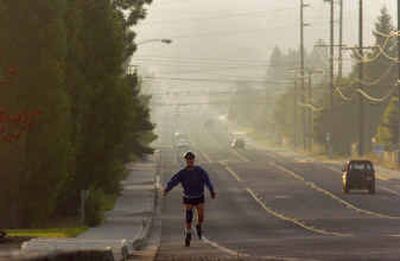Region eats smoke from B.C. fires

Massive wildfires in British Columbia have created unhealthy breathing conditions in the Spokane area for the elderly and young children.
The air is slightly clearer over North Idaho, but winds will continue to import thick smoke and haze from the burning forests, according to weather forecasts.
Spokane’s smoky air level spiked to 110 micrograms of particles per cubic meter Tuesday, said Ron Edgar, chief of technical services with the Spokane County Air Pollution Control Authority. That’s nearly 10 times dirtier than the typical readings on a clear summer day. The federal government threshold for unhealthy air for sensitive individuals is a 24-hour average of 100 micrograms.
The smoke is thickest during the evening and early morning, when cool air sinks to the ground.
“We could see very high levels,” Edgar said, adding, “It looks like the pattern will continue for a couple of days.”
The small particles from wood smoke can travel deep into the lungs and make breathing difficult, especially for people with weakened hearts and lungs. Even healthy adults may experience chest pains, fatigue and shortness of breath, according to information from the U.S. Environmental Protection Agency.
As of Tuesday afternoon, Spokane’s 24-hour average air quality index was 93 micrograms. The levels were a bit healthier in North Idaho, with Sandpoint at 72 and Coeur d’Alene at 52, according to readings taken just before noon, the most recent available.
The smoke arrived after the winds shifted Monday afternoon and began blowing in air from the northwest, where 370,000 acres in British Columbia are burning. Some of the smoke also was produced by the 15,000-acre Pot Peak fire, which has been burning for the last month near Chelan, Wash.
The plume hit Colville late Monday afternoon. By 9:30 p.m. it had arrived in north Spokane. The city was blanketed within 15 minutes, according to readings from SCAPCA. The levels peaked in Spokane around midnight.
“I was expecting it to a certain extent, but not quite as fast as it arrived,” Edgar said.
Robin Fox of the National Weather Service in Spokane referred to the dry cold front as a “smoke front.” Visibility at Felts Field in Spokane dropped to 2.5 miles at 11 p.m. She said conditions in Spokane and North Idaho should improve as light winds were forecast to blow out of the northeast today.
Air quality in Post Falls spiked about 4 a.m. Tuesday with a reading of 95 micrograms per cubic meter. Summertime air quality in North Idaho is typically about 10 micrograms per cubic meter, said Dan Redline, air quality analyst for the state’s Department of Environmental Quality. The last time smoke was this thick in the Coeur d’Alene area was 1999.
All burning has already been banned in Spokane County. Agricultural burning also has been halted without exception across Eastern Washington, according to the state’s Department of Ecology Web site.
In North Idaho, field burning was not permitted Tuesday because of the smoky conditions. A limited amount of burning occurred in Latah County Monday, Redline said.
Officials debated banning all open burning in North Idaho because of the smoke, but the trigger point of 80 micrograms per cubic meter had not yet been crossed, Redline said. “Our best estimate was that we would see improvement.”
The forecast calls for continued northerly winds, which will blow more of the smoke down from wildfires burning in British Columbia, but Fox said most of the smoke would drift across areas to the west of Spokane.
As of Monday, 373 fires were burning in the province, which is 10 times more than last year at this time, according to published reports in The Vancouver Sun newspaper. The summer of 2003 was the worst fire season in 50 years for British Columbia.